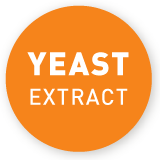All over the world and in all cultures, foods are seasoned. In Asian countries, fish and soy sauces are often popular taste enhancers, whilst in western cuisine tomato purée and Parmesan cheese are used for this purpose.
As with yeast extract, all of these condiments have a natural origin. Production, too, is very similar and based on largely identical processes:
Yeast extract is produced without any chemical additives with the aid of enzymes which divide the proteins in yeast into their taste-providing elements. These are separated from the insoluble residual constituents and dried. The result of this process is yeast extract – a mix of different amino acids, carbohydrates, vitamins and minerals.
Parmesan, as well as soy sauce and fish sauce, is produced in a very similar way: For Parmesan, lactic acid bacteria and enzymes are added to the raw milk, in order to induce coagulation. The curd is then preserved in brine, separated from the whey and finally matured. Enzymes are also added to soybeans; fish does not require the addition of any enzymes. The fully fermented soy sauce or fish sauce is separated from other components by extraction.
The fermentation and maturation processes which these condiments go through contribute to their hearty taste. Just like other traditional condiments, yeast extract also gives the foods taste. In addition, it also emphasises the taste of other ingredients. Even a small amount of yeast extract does a great deal towards achieving a special, savoury taste – the concentration of yeast extract in foods is commonly less than one per cent.



